Abstract
To comparatively evaluate the suitability of superhydrophobic and superhydrophilic coatings for photovoltaic (PV) module surfaces in arid and low-rainfall regions, this study investigates their dust deposition mitigation performance under anhydrous conditions and assesses the impact of dust reduction on PV power generation efficiency. An experimental platform for dust deposition and a PV output measurement system were constructed to evaluate the performance of coated PV modules. The open-circuit voltage (Uoc), short-circuit current (Isc), maximum power (Pmax), and dust deposition mass were measured before and after dust exposure. Additionally, the influence of coating properties on dust deposition behavior and the correlation between dust deposition density and PV output power were systematically examined. The experimental data reveal a linear relationship between PV output power loss and dust deposition density. Dust accumulation decreases monotonically with panel tilt angle, while displaying a non-monotonic response to wind speed, peaking at 3.9 m/s. Under optimal conditions (60° tilt angle and 5.2 m/s wind speed), minimal dust deposition densities were observed: 0.25 g/m2 for superhydrophobic coated PV modules versus 1.11 g/m2 for superhydrophilic coated surfaces. Both superhydrophobic and superhydrophilic coatings demonstrated effective dust deposition inhibition in anhydrous environments. However, the dust deposition mitigation efficiency of the superhydrophobic coating (88.7%) is significantly better than that of the superhydrophilic coating (46.2%) under the working conditions of a large inclination angle (60°) and high wind speed (5.2 m/s). These findings provide critical experimental evidence for optimizing self-cleaning coating selection in PV modules deployed in arid regions.
1. Introduction
With increasing global demand for renewable energy, solar power has emerged as a prominent clean energy solution, attracting significant research interest and achieving large-scale implementation [1,2,3,4]. Given the extensive land requirements and optimal solar irradiance distribution, large-scale PV power plants are predominantly deployed in arid desert regions [5,6,7,8,9,10]. However, the atmospheric dust density in these regions is very high and particles are constantly accumulating on the surface of the PV modules. This deposition greatly reduces the glass transmittance, leading to a significant decrease in power conversion efficiency [11,12,13,14,15,16]. Research indicates that dust-induced power output reduction in PV modules exhibits strong dependence on multiple environmental and operational parameters, notably wind speed, panel tilt angle, areal dust density, particulate composition, and maintenance frequency. Critical performance degradation occurs at 7.155 g/m2 dust accumulation, with measured power output reductions of 45%–55% compared to clean modules [17,18,19,20].
Currently, dust cleaning methods include electrostatic, robotic, mechanical, washing and self-cleaning coating approaches. Liu et al. demonstrated that carbon nanotube-based transparent conductive thin films (CNT-TCTFs) achieved 99.78% dust removal efficiency when applying a 6 kV/cm electrostatic field [21]. Zhao et al. developed an assisted-frame robotic cleaning system that exhibited a positive correlation between dust removal efficiency and areal dust density. The system achieved a peak cleaning efficiency of 27.8% at a critical dust load of 10.36 g/m2, demonstrating its effectiveness for heavily soiled PV arrays [22]. Navaei et al. systematically examined the correlation between water mist droplet diameter and the PV module cleaning efficiency [23]. Their results demonstrated a positive monotonic relationship, with dust removal efficiency increasing proportionally to droplet size. Optimal performance was achieved at a 113 μm droplet diameter, yielding 22.72% dust removal efficiency under standardized test conditions. Attia et al. quantitatively analyzed the influence of mechanical vibration amplitude on PV panel dust removal efficiency. Their experimental results demonstrated a strong positive correlation between dust mitigation performance and input wind speed during shaker operation [24]. Zheng et al. summarized existing PV de-dusting technologies [25]. Consequently, developing cost-effective and efficient dust mitigation strategies for PV systems remains a critical research priority. While conventional water washing demonstrates effective dust removal, its practical implementation faces two significant limitations: high operational costs in water-scarce arid regions, and potential for irreversible surface damage when using improper cleaning techniques [26]. These constraints necessitate alternative approaches that balance cleaning performance with economic and environmental sustainability. To address this challenge, researchers have developed self-cleaning coatings, including superhydrophilic and superhydrophobic materials to reduce dust deposition on PV modules.
Current research on self-cleaning coatings primarily focuses on assessing single-coating dust mitigation performance through combined experimental and numerical simulation approaches. Lu et al. investigated the dust deposition mitigation efficiency of superhydrophobic coatings at different inclination angles, wind speeds, and wind directions, and the results show that the dust deposition mitigation efficiency reaches 94.43% when the PV module tilt angle is 75°. The dust deposition mitigation efficiency reaches a maximum of 28.81% when the wind speed reaches 1.2 m/s. The superhydrophobic coating shows a good dust deposition mitigation performance under different conditions [27]. Wu et al. proposed that superhydrophobic coatings can effectively solve the problem of dust deposition on PV glass surfaces [28]. Zhao et al. conducted a comprehensive numerical simulation study comparing dust deposition characteristics between superhydrophobic-coated and uncoated PV modules across varying wind speeds and tilt angles. Their results demonstrate that superhydrophobic coatings significantly suppress dust accumulation, with a 37.4% reduction observed under optimal conditions (7 m/s wind speed, 30 μm particle size, 60° tilt angle) compared to untreated surfaces. This quantitative analysis establishes the coating’s effectiveness in real-world operating environments [29]. Piliougine et al. developed an advanced superhydrophobic coating that reduced PV module daily energy losses to 2.5% under dry conditions, demonstrating a 24.2% improvement over uncoated modules (3.3% daily loss). This performance enhancement highlights the coating’s potential for maintaining energy output in water-scarce environments [30]. Zhao et al. investigated the dust removal performance of superhydrophilic coatings under water shower conditions. The results show that the self-cleaning efficiency of the superhydrophilic coating can reach up to 92%, and it can improve the spectral transmittance of the PV glass, with the greatest increase in transmittance of 26.5% at an inclination angle of 60° [31]. Ahmed et al. conducted an outdoor experiment to study the dust deposition mitigation performance of superhydrophilic coatings on PV modules. The results show that the superhydrophilic coating can effectively reduce the amount of dust deposition and improve the power generation efficiency of the PV modules. The average short-circuit current of the coated panels was 2.8 A, which was 64.7% higher than that of the uncoated panels, and the average output power was 24.75 W, which was twice as much as that of the uncoated panels. In addition, the efficiency of the coated panels reached 12%–13.5% under peak insolation conditions, compared to only 7%–8% for the uncoated panels [32]. Chundi et al. developed a superhydrophilic coating using TiO2 nanoparticles as raw material and experimentally verified the good durability and antifouling properties of the coating [33].
While previous studies have extensively examined individual coatings for dust deposition mitigation, a systematic comparison of superhydrophilic and superhydrophobic coatings, particularly their effects on PV output characteristics under varying environmental conditions, remains unexplored. Moreover, many of these studies overlook the fundamental role of coating microstructure in dust adhesion, a critical factor governing long-term performance. Notably, advances in thin-film deposition techniques have demonstrated the importance of microstructure control. For instance, Todor-Boer et al. conducted a comparative study of hybrid thin films fabricated via spin-casting and convective self-assembly, revealing that the latter method enables precise microstructure modulation. Their findings showed that convective self-assembly, especially at low deposition speeds, promotes highly ordered eutectic structures, which significantly influence the films’ optoelectronic properties [34]. Similarly, Oke et al. evaluated conventional thin-film deposition methods and emphasized the future potential of atomic layer deposition (ALD) for achieving superior microstructural precision [35].
This study aimed to address a critical research gap by conducting comprehensive investigations on three key aspects. First, we performed a systematic characterization of coating surface microstructures and detailed analysis of surface properties, elucidating the distinct self-cleaning mechanisms of both superhydrophobic and superhydrophilic coatings. This included an in-depth examination of their functional mechanisms in dust deposition mitigation processes, with particular attention to the interfacial interactions between coating surfaces and dust particles.
Second, we performed a comparative analysis of dust deposition characteristics on superhydrophobic and superhydrophilic coatings under varying environmental conditions. By systematically evaluating the coating performance across different wind speeds (1.3–5.2 m/s) and tilt angles (30–60°), we quantitatively assessed their relative effectiveness in dust deposition mitigation.
Third, this study investigated the direct effect of dust deposition mitigation on the output power of PV modules. The power loss before and after dust deposition on coated modules was measured through controlled experiments, and the mitigation effect of coatings on dust deposition was quantified.
2. Materials and Methods
2.1. PV Module Dust Deposition Experiment
This experiment adopted the method of indoor experiments, which is more controllable compared with outdoor experiments, facilitates the repetition of experimental verification, and improves the accuracy of experimental data. In order to simulate the process of dust deposition on PV modules under natural conditions, we built a dust deposition experimental platform, which is capable of adjusting the inlet wind speed and the tilt angle of PV modules. Meanwhile, the platform has a constant temperature and humidity, which reduce the interference of environmental factors on the experimental results. The platform consists of an air supply device, a dust-blowing device, and a dust collection device, and the schematic and physical drawings of the dust deposition experimental platform are shown in Figure 1 and Figure 2, respectively. At the entrance of the platform, an inverter fan (HF-250PE, Shenzhen, China) is installed to generate a natural flow of air to carry dust into the experimental area. The experimental measurement area is a sealed rectangular air box with a volume of 0.5 m × 0.5 m × 1.0 m. In order to reduce the inhomogeneity of the inlet air velocity, the inlet and outlet of the test area are equipped with filters with uniformly densely packed circular holes. The test area is equipped with an anemometer (HT-9829, Shenzhen, China), thermometer (DM6801A, Shenzhen, China), and humidity controller (SV-202B-3, Guangzhou, China) to simultaneously measure the temperature and humidity of the test environment as well as the wind speed. A dust collector is connected to the outlet of the wind box, which can collect the dust blown out from the end of the wind box to avoid causing environmental pollution. The soot-blowing device consists of an air pump (ACO-003, Zhoushan, Zhejiang), a particulate matter reservoir, and a rubber hose, which is connected to the particulate matter reservoir and fixed to the top of the mixing zone of the airbox by means of a rubber hose. Meanwhile, the platform has a constant temperature and humidity, which reduce the interference of environmental factors on the experimental results.

Figure 1.
Schematic diagram of PV module dust deposition experimental platform.
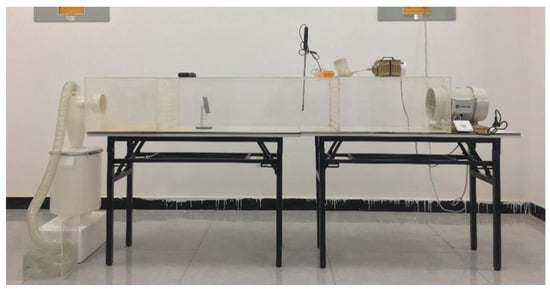
Figure 2.
Experimental platform for PV module dust deposition.
Two PV modules purchased in the same batch with the following product specifications were used for the experiment: monocrystalline silicon, Pmax: 3 W ± 5%, Uoc: 6 V ± 5%, Isc: 660 mA ± 5%. Prior to the experiment, the two PV modules were first cleaned with an ethanol solution for 5 min to ensure that the impurities and oils remaining on the PV modules were completely removed. Then, we gently wiped the panel with a clean rag or paper towel to further remove any remaining moisture and impurities. The two PV modules were then placed in an oven at 40 °C for two hours. After the surfaces of the PV modules were completely dry, the superhydrophilic and superhydrophobic coatings were uniformly sprayed onto the two PV modules with a spray gun. The two PV modules were left to stand for 12 h. After the coating was fully cured, the experiments were carried out on the two PV modules in turn. After the experiment was initiated, the airflow was blown from the inlet of the airbox for a duration of 15 s to ensure that the air velocity reached a constant state. After the wind speed was stabilized, the air pump was turned on to blow the dust from the particulate storage into the air box in a stable and continuous manner for 20 s, and then the dust emitter was turned off. In order to ensure that the dust could be fully mixed with the airflow and carried evenly, it was necessary to continue to send air for 15 s. The fan was then turned off and left to stand for 5 min, allowing the dust in the airbox to settle naturally on the PV modules without external interference. In the experiments, the original PV module without superhydrophobic coating was recorded as A, the PV module treated with superhydrophobic coating as B, the original PV module without superhydrophilic coating as C, and the PV module coated with superhydrophilic coating as D.
2.2. Experiments on PV Module Power Generation Output Characteristics
To evaluate the output characteristics of PV modules, a dedicated test platform was constructed, as illustrated in Figure 3. The setup employed two 500 W high-voltage spherical xenon lamps (XHA500 W, Shenzhen, China), each equipped with dual-end triggers to ensure reliable ignition. A voltage stabilizer was integrated to maintain a constant input voltage. The current–voltage (I–V) and power–voltage (P–V) curves of the PV modules were acquired using a PV curve tracer interfaced with a computer for real-time data visualization. The impact of dust deposition on module performance was quantified by measuring the open-circuit voltage (Uoc), short-circuit current (Isc), and maximum power output (Pmax) before and after dust application. Additionally, the mass of deposited dust on PV modules with different self-cleaning coatings was determined using a high-precision electronic analytical balance (FA224, Shanghai, China; resolution: 0.0001 g). By correlating the dust accumulation mass with the corresponding power loss under identical test conditions, the self-cleaning efficacy of the coatings was objectively evaluated, enabling a comparative assessment of their performance.
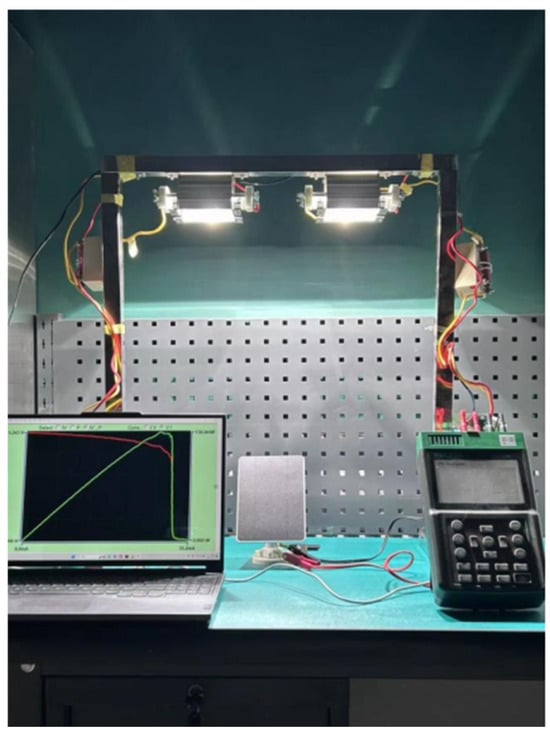
Figure 3.
PV module output characteristic measurement platform.
2.3. Preparation of Self-Cleaning Coating
In order to prepare the superhydrophobic coating, the hydrophobic silica sol was first pre-made. Tetraethoxysilane (TEOS) was taken (2.1 mL), slowly added dropwise to ethanol (30 mL), and mixed continuously for 10 min under strong stirring. Subsequently, 2.0 mL of hexamethyldisilazane (HMDS) was gradually added to the mixture, and the stirring reaction lasted for 0.5 h. At room temperature, deionized water (3.0 mL) was added dropwise at the same stirring rate, and the reaction was continued with stirring until the solution became clear and a hydrophobic silica sol was formed. After aging the silica sol for 48 h, silica nanoparticles (0.2 g) were added to the aged silica sol (10 mL), and the mixture was magnetically stirred until the mixture was homogeneous. Subsequently, an appropriate amount of the mixed sol (accurately controlled between 1 and 50 drops with a dropper) was added to 1 mL of ethanol and processed under ultrasonic shaking for 5 min to obtain a homogeneous sol solution.
To prepare superhydrophilic coatings, titanium dioxide and silica sols were preformed using tetrabutyl titanate and ethyl silicate as precursors, respectively. Ethyl silicate, ethanol (99%), and polyethylene glycol were mixed homogeneously, and then acetic acid (99.8%) was added slowly to adjust the pH value to an acidic environment, to inhibit the rapid hydrolysis of ethyl silicate, and transparent silica sol was obtained by stirring for one hour at room temperature. Tetrabutyl titanate was mixed with ethanol and stirred for 30 min, then acetic acid, distilled water, and ethanol were added slowly, and stirring was continued at room temperature to obtain the sol. The obtained silica sol and titanium dioxide sol were mixed in the ratio of 1:2 and stirred for 4 h to form a homogeneous sol. After aging the sol for 48 h, the sol was uniformly coated on the bare glass samples.
3. Results and Discussion
3.1. Surface Characterization of PV Modules with Different Coating Surfaces
Surface energy is a key parameter that determines the surface behavior of materials and has a decisive influence on the dust deposition mitigation performance of self-cleaning coatings for PV modules. Since the surface energy of solids is difficult to measure directly, in this study, the surface energy of different surfaces was calculated by measuring the contact angle and using a method for calculating the surface energy of solids based on Kwok et al. [36], as shown in Equation (1):
where α is the size of the contact angle; is the surface energy of the solid; is the surface energy of the liquid, also known as surface tension; and β is an empirical constant, usually taken as 1.25 × 10−4 m2/mJ.
The contact angles of PV modules with different surface coatings are presented in Figure 4. The superhydrophobic coating demonstrated a contact angle of 152.3° and a surface energy of 0.25 mJ/m2, indicating extreme hydrophobicity and ultralow surface energy [37,38]. The minimal surface energy significantly weakens the adhesion between dust particles and the coating. When dust impacts the surface, kinetic energy dissipation is suppressed, promoting elastic collisions and particle rebound, thereby facilitating dust detachment from the PV module. In contrast, the superhydrophilic coating exhibited a contact angle of 3.6° and a surface energy of 72.8 mJ/m2. The high surface energy enhances dust-particle adhesion, causing rapid kinetic energy dissipation upon impact. Consequently, particle rebound is substantially diminished, often resulting in direct adsorption. While this promotes dust rolling or sliding, the strong adhesive forces lead to comparatively weaker dust deposition mitigation. The uncoated PV module is 37.9°, the surface energy is 58.3 mJ/m2, the surface energy is between superhydrophobic and superhydrophilic, the dust adhesion is moderate, the particles may partially rebound after collision, but its surface is relatively smooth, the dust particles have a large contact area with the surface, and it is easy to be piled up into a mass by gravity or wind.
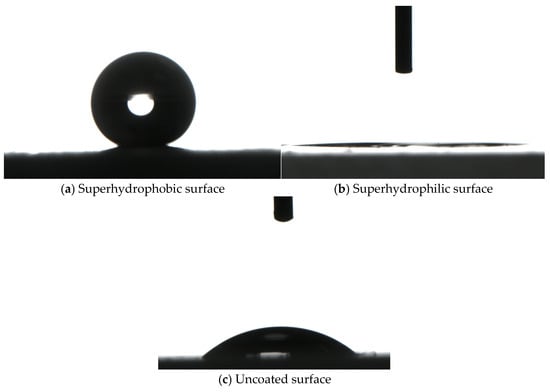
Figure 4.
Contact angles of solar cell covering glass with and without coating.
To further characterize the surface microstructure of the coatings, scanning electron microscope (SEM) images of the superhydrophilic and superhydrophobic coatings were obtained using a Hitachi cold-field emission scanning electron microscope (SEM, HITACHI-SU8600, Shanghai, China), as shown in Figure 5. Characterization results show that both superhydrophilic and superhydrophobic coating surfaces have micro- and nano-rough structures, which inhibit the deposition of dust. However, there is a significant difference between the two different coating morphological features. The surface of the superhydrophilic coating has tiny, dense, and uniform pores and pits, while the superhydrophobic coating has a micro-nanometer-scale papillae structure and the surface roughness presents non-uniform distribution characteristics. These structural differences underlie their respective anti-dust mechanisms: the hydrophilic coating’s nanoporosity enhances surface wetting and dust encapsulation, while the hydrophobic coating’s multiscale roughness minimizes particle–surface interactions through reduced adhesion forces.
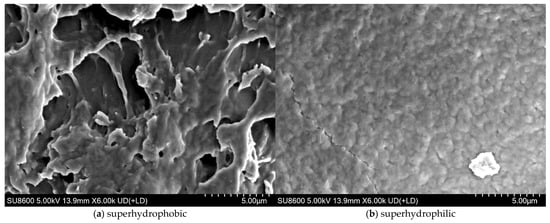
Figure 5.
Electron microscope scanning images of different coated surfaces. (a) Surface structure of the superhydrophobic coating; (b) surface structure of the superhydrophilic coating.
Figure 6 shows atomic-force microscopy (AFM, Bruker MM8, Billerica, MA, USA) images of the superhydrophobic and superhydrophilic coatings with a scanning area of 10 μm × 10 μm. The surface of the superhydrophobic coatings has a nipple-like microstructure with a height variation of about 200 nm and an average roughness (Ra) of 20.4 nm. The surface exhibits a periodic nanoscale roughness texture densely populated with pores and grooves, which promotes the formation of a stable air cushion layer. This layered structure mimics the “lotus leaf effect”, which significantly enhances the hydrophobicity of the surface. In addition, the rough morphology significantly reduces the contact area of the dust particles with the surface, thereby reducing the adhesion of the particles. The surface of the superhydrophilic coating also has a nanoscale roughness structure, but its morphological characteristics are significantly different from those of the superhydrophobic coating. Specifically, the surface height difference in the superhydrophilic coating is about 100 nm, which is only half of that of the superhydrophobic coating, and the surface Ra is 12.2 nm. Compared with the superhydrophobic coating, the nanostructure of the superhydrophilic coating is denser, with a more homogeneous height distribution, and only a few tiny pits and pores. This fine microstructure can reduce the contact area of dust particles with the substrate to a certain extent, but its effect of mitigating dust deposition is still weaker than that of the superhydrophobic surface.
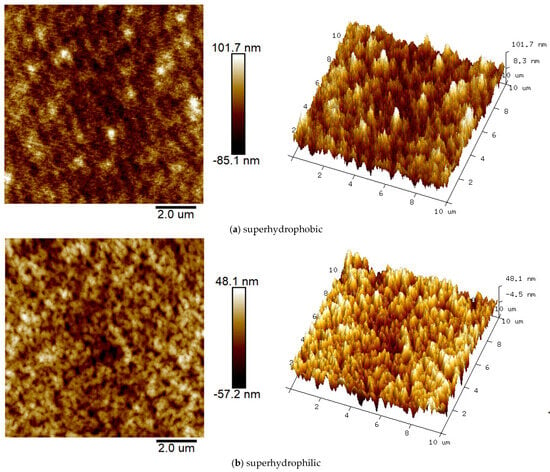
Figure 6.
AFM images of different coated surfaces. (a) AFM morphology of superhydrophobic coated surfaces; (b) AFM morphology of superhydrophilic coated surfaces.
3.2. Effect of Tilt Angle on Dust Deposition Characteristics and Output Characteristics of PV Modules with Different Coatings
The tilt angle of PV modules significantly influences dust deposition behavior, and in order to investigate the effect of tilt angle on the dust deposition characteristics of PV modules with different coating surfaces, three different tilt angles were selected: 30°, 45°, and 60°. These angles are based on the optimal annual power production in the latitude 30° to 60° area. As shown in Figure 7 and Table 1, experimental results obtained at a controlled wind speed of 1.3 m/s reveal an inverse relationship between tilt angle and dust accumulation, with deposition mass decreasing by approximately 29%~50% as the inclination increases from 30° to 60°. This trend is consistent across all tested surface coatings, though the absolute deposition rates vary significantly between superhydrophobic, superhydrophilic, and uncoated modules. Experimental results obtained at a constant wind speed of 1.3 m/s demonstrate distinct dust deposition patterns and corresponding power losses across different module types and tilt angles, as Table 1 shows. For uncoated module A, dust accumulation decreased from 2.74 g/m2 to 1.93 g/m2 as tilt increased from 30° to 60°, accompanied by a reduction in power loss from 86.1 mW to 67.3 mW. Superhydrophobic-coated module B showed a superior performance, with deposition density declining from 2.33 g/m2 to 1.16 g/m2, a 50.2% reduction, and power loss decreasing from 76.4 mW to 40.0 mW, a 47.6% improvement, across the same angular range. Statistical analysis revealed a strong positive correlation between areal dust density and power degradation (ΔP), confirming that increased particulate accumulation directly reduces module output.
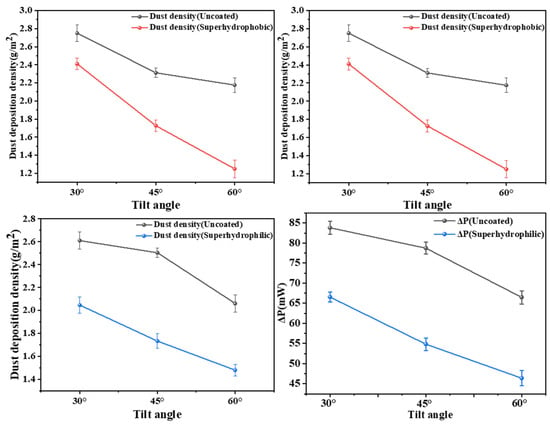
Figure 7.
Dust deposition characteristics and power loss of PV modules on different surfaces at different tilt angles under a wind speed of 1.3 m/s.

Table 1.
Dust deposition density and power loss of PV modules at different tilt angles.
This phenomenon mainly stems from the masking effect of dust particles on incident light: the higher the density of dust, the more serious the degree of masking on the surface of the module, leading to a decrease in light transmittance, thus reducing the photoelectric conversion efficiency. It is worth noting that at the same inlet wind speed, the dust density and the loss of output power (ΔP) of PV modules with different coating surfaces show a decreasing trend with the increase in tilt angle. This indicates that the larger the tilt angle of the PV module, the less favorable it is for dust to be deposited on the surface of the PV module, which in turn leads to a smaller amount of output loss in the PV module. This is because the dust particles fall off on the surface of the PV module. On the one hand, under the influence of gravity, with the increase in the tilt angle of the PV module, the dust particles are subjected to an increase in the gravity of the component force, while the normal support force decreases, which leads to a lack of friction force and is unable to balance the gravitational force of the component force, which triggers the dust particles to slip and fall off. On the other hand, it is affected by the collision force, and when the dust particles collide with the surface of the PV module at a greater angle, the normal rebound force applied increases, resulting in the dislodgement of the dust particles. It is also worth noting that the coated PV modules only change the dust deposition density at different inclination angles, but not the overall trend of dust deposition.
To evaluate the dust mitigation performance of PV modules with different surface coatings, we analyzed the dust deposition mitigation efficiencies of superhydrophobic (Module B) and superhydrophilic (Module D) coated surfaces across multiple tilt angles (30°, 45°, and 60°), as illustrated in Figure 8. The results demonstrate a positive correlation between tilt angle and dust mitigation efficiency for both coating types. Module B (superhydrophobic) exhibited dust mitigation efficiencies of 15.1%, 28.8%, and 39.7% at 30°, 45°, and 60° tilt angles, respectively. Comparatively, Module D (superhydrophilic) showed efficiencies of 21.3%, 29.7%, and 32.6% at the corresponding angles. Notably, while both coatings showed improved performance with an increasing tilt angle, the superhydrophobic coating (Module B) demonstrated a superior dust mitigation capability at steeper angles (particularly at 60°), suggesting enhanced self-cleaning properties under greater inclination. This differential performance highlights the tilt-angle-dependent effectiveness of superhydrophobic versus superhydrophilic surface treatments for PV applications.
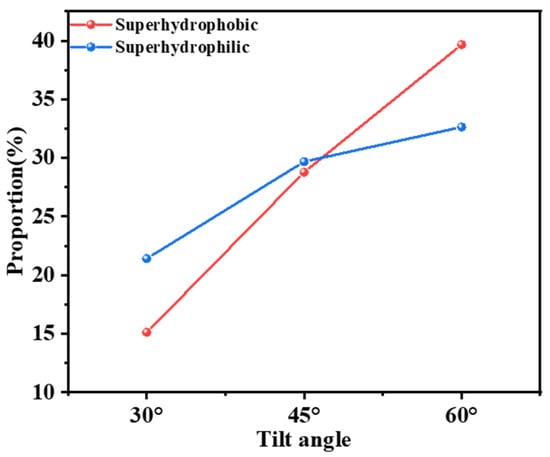
Figure 8.
Efficiency of different coatings in mitigating dust deposition on PV modules at different tilt angles.
3.3. Effect of Inlet Wind Speed on Dust Deposition Characteristics and Output Characteristics of PV Modules with Different Coatings
Wind speed is another important factor affecting the dust deposition of PV modules. In order to investigate the effect of inlet wind speed on the dust deposition characteristics and output characteristics of PV modules with different surfaces, four different inlet wind speeds were selected: 1.3 m/s, 2.6 m/s, 3.9 m/s, and 5.2 m/s. Figure 9 shows the dust deposition characteristics and lost power of PV modules with different coated surfaces at different wind speeds and a tilt angle of 30°. The experimental data show that at a tilt angle of 30° and wind speeds of 1.3 m/s, 2.6 m/s, 3.9 m/s, and 5.2 m/s, the dust deposition densities of PV module A are 2.74 g/m2, 3.29 g/m2, 3.82 g/m2, and 3.02 g/m2, and the output power losses are 86.1 mW, 103.1 mW, 117 mW, and 94.8 mW, respectively; the dust deposition densities of PV module B are 2.33 g/m2, 2.56 g/m2, 2.94 g/m2, and 2.11 g/m2, and the output power losses are 76.4 mW, 80.3 mW, 90.8 mW, and 66.3 mW; the dust deposition densities of PV module C are 2.62 g/m2, 3.18 g/m2, 3.94 g/m2, and 2.92 g/m2, and the output power losses are 82.1 mW, 96.5 mW, 118.6 mW, and 90.5 mW, respectively; the dust deposition densities of PV module D are 2.06 g/m2, 2.45 g/m2, 2.66 g/m2, and 2.21 g/m2, and the output power losses are 65.1 mW, 76.9 mW, 84.0 mW, and 69.3 mW. The results show that the amount of dust deposition and output power loss of PV modules on different surfaces show a tendency of increasing and then decreasing with the increase in wind speed, and both of them reach the maximum value when the wind speed is 3.9 m/s. This phenomenon occurs because dust particle movement in the flow field is governed by the combined effects of airflow traction and gravity. In the low-wind-speed conditions, the dust particles show quasi-static migration characteristics, and their trajectory is parabolic. Under low-wind-speed conditions, the relative motion between the airflow and the dust particles is weak, and the airflow produces less fluid drag on the particles. At this time, large-sized dust particles, due to their larger mass, have a significantly smaller movement speed than small-sized particles and, under the action of gravity, are more likely to settle and fall to the ground earlier. As the wind speed increases, the initial kinetic energy obtained by the dust particles is significantly increased, so that particles of different sizes can overcome the critical kinetic energy threshold and reach the surface of the PV module, resulting in an increase in the density of dust deposition on its surface, which in turn leads to the attenuation of the PV module output power.
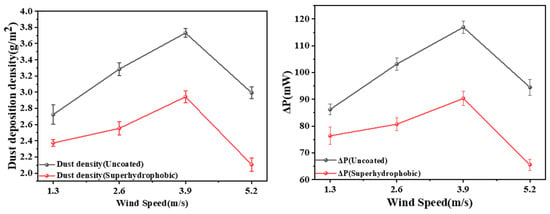

Figure 9.
Dust deposition characteristics and lost power of PV modules with different coating surfaces at different wind speeds.
Figure 10 demonstrates the efficiency of PV modules with different coating surfaces for dust deposition mitigation at different wind speeds. It can be seen that the efficiency of PV module B with a superhydrophobic coating surface for dust deposition mitigation increases with the increase in wind speed and reaches a maximum of 30.1% at a wind speed of 5.2 m/s. The efficiency of dust deposition mitigation of PV module D with a superhydrophilic coating surface showed a trend of increasing and then decreasing, and the mitigation efficiency reached a maximum of 34% when the wind speed was 3.9 m/s, while it showed a decreasing trend when the wind speed was increased to 5.2 m/s. This is because when the wind speed increases to 5.2 m/s, the turbulence energy in the wind box increases, which can mean the dust particles can be deposited twice, while on the surface of the superhydrophilic coating, due to the very high surface energy, it is difficult to again deposit dust particles to realize the rebound. While the surface energy of the superhydrophobic coating is low and the contact area between the dust particles and the surface of the PV module is small, the secondary deposition of dust particles are unable to reoccur, permitting the rebound behavior in which they fall off from the PV module. Therefore, the dust deposition mitigation efficiency of the superhydrophilic coated surface reaches its maximum at an inlet wind speed of 3.9 m/s, whereas that of the superhydrophobic coated surface reaches its maximum at an inlet wind speed of 5.2 m/s.
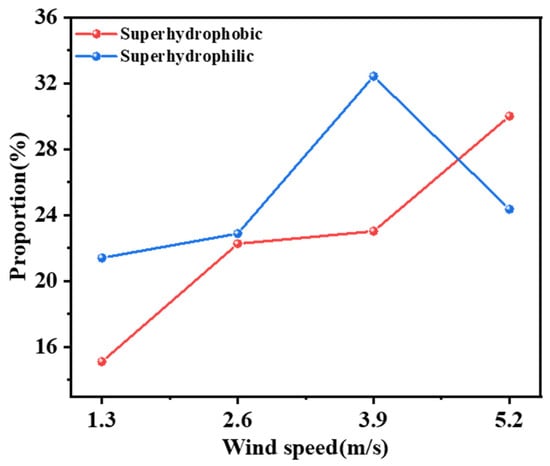
Figure 10.
Efficiency of PV modules with different coating surfaces for dust deposition mitigation at different wind speeds.
3.4. Dust Deposition Behavior and Output Characteristics of PV Modules with Different Coatings
In order to study the dust deposition mitigation mechanism of these two coatings in depth, we conducted dust deposition experiments on PV module B with a superhydrophobic coating surface, PV module D with a superhydrophilic coating surface, and PV module C without coating under the conditions of a wind speed of 1.3 m/s and tilting angle of 45°, respectively, and the before and after contrasts of the dust deposition are shown in Figure 11. The experimental results show that the surface dust deposition mass of PV module B with a superhydrophobic coated surface, PV module D with a superhydrophilic coated surface, and uncoated PV module C are 29.2 mg, 32.7 mg, and 46.5 mg, respectively. PV module C has the largest amount of dust deposition, followed by PV module D, and PV module B has the smallest amount of dust deposition. The dust deposition density of coated PV modules is lower than that of uncoated PV modules due to the fact that both superhydrophobic and superhydrophilic coatings have micro- and nano-scale roughness structures, which can significantly reduce the contact area of dust particles with the surface of PV modules and effectively reduce the dust deposition density. However, compared to superhydrophobic coatings, the micro- and nanostructures of superhydrophilic coatings are more homogeneous and denser, resulting in a relatively large contact area between the dust particles and the PV substrate, and a corresponding increase in the adhesion force exerted on the surface by the dust particles. In terms of dust deposition patterns, dust detachment or rolling-off phenomena occurred locally on the surface of PV module B, while the dust of PV module D showed a uniform distribution on its surface, and the dust distribution on the surface of PV module C was relatively uniform, with the phenomenon of dust aggregation occurring locally in a distinctly granular manner, but no obvious detachment phenomenon occurred. This is related to the surface energy of the dust contact interface: where the superhydrophilic coating has a high surface energy, and the adhesion force suffered by the dust upon deposition is high, the low surface energy of the superhydrophobic coating makes it difficult for dust to adhere to its surface. Due to the large tilt angle, the loose dust particles tended to roll downward under the combined effect of the wind’s traction force and the gravitational component force; the surface energy of uncoated PV modules is intermediate between superhydrophilic and superhydrophobic coatings, so the dust distribution is relatively homogeneous with localized agglomeration.
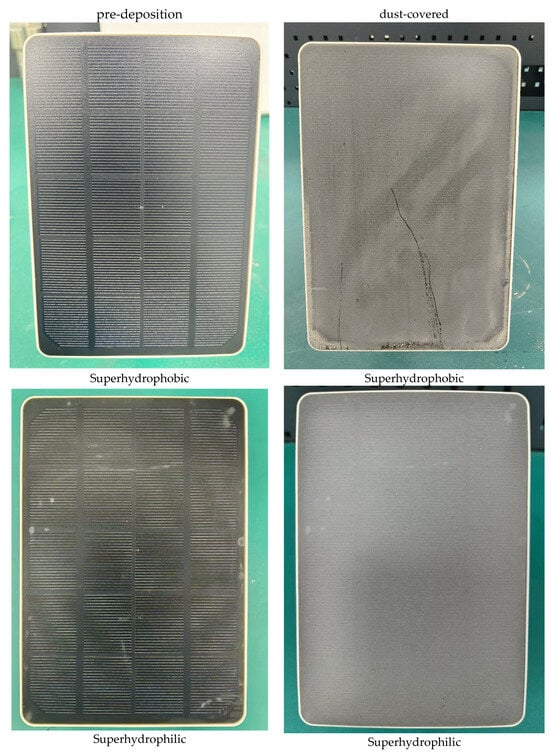
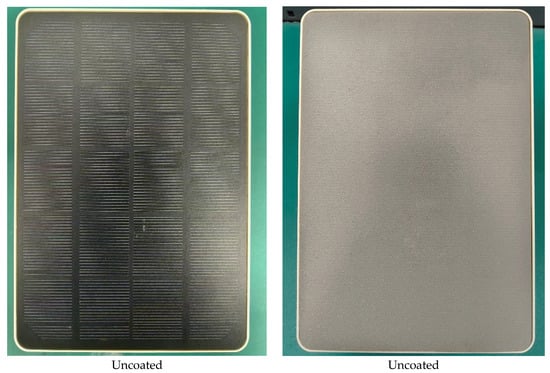
Figure 11.
Before and after comparison of dust deposition on superhydrophobic, superhydrophilic, and uncoated PV modules at a wind speed of 1.3 m/s and a tilt angle of 45°.
In order to further observe the dust deposition process on PV modules with different coating surfaces, we employed a high-speed camera to capture the deposition behavior of dust particles on PV modules with superhydrophobic and superhydrophilic coating surfaces, as shown in Figure 12 and Figure 13. Figure 12 illustrates the dust deposition behavior on a superhydrophobic coated PV module at a 30° inclination angle and 2.6 m/s wind speed. It can be observed from the figure that the dust particles, after making contact with the surface of the PV module, move towards the lower side of the PV module through “bouncing” behavior, and after 21.5 milliseconds (ms), rebound to reach the highest point of the whole process, and then enter the descending phase.
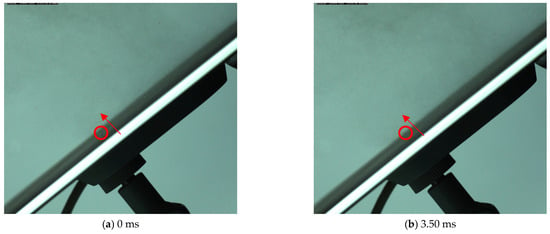
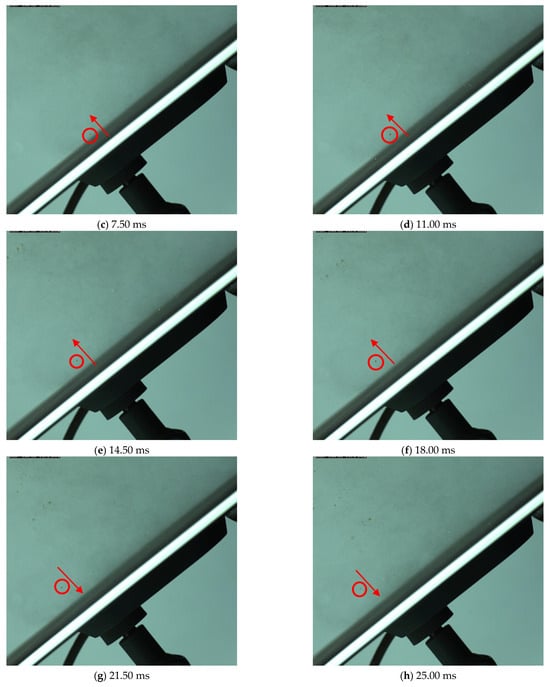
Figure 12.
Dust deposition on PV module with superhydrophobic coated surface at 30° inclination and 2.6 m/s wind speed.
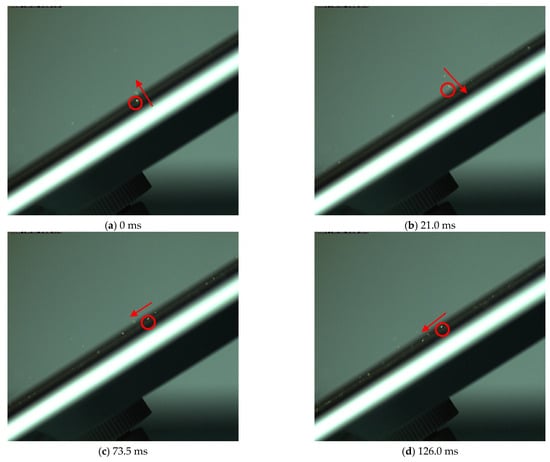
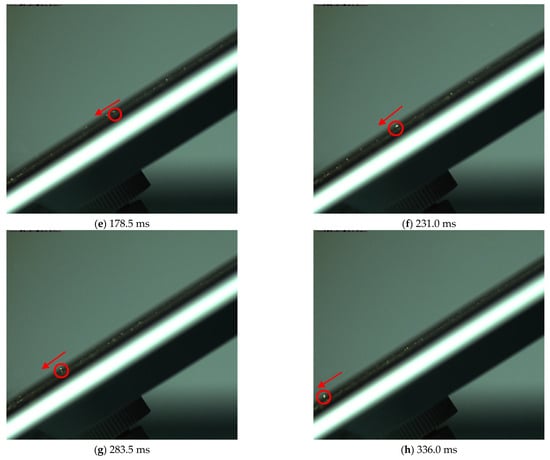
Figure 13.
Dust deposition on PV module with superhydrophilic coating surface at 30° inclination and 2.6 m/s wind speed.
Figure 13 demonstrates the dust deposition behavior on the surface of the superhydrophilic coated PV module at an inclination angle of 30° and a wind speed of 2.6 m/s. From the figure, it can be observed that the dust particles, after contacting with the surface of the PV module, reach the highest point of the rebound motion after 21 ms, then enter a descending phase and are deposited again on the surface of the PV module after 73.5 ms. Thereafter, the dust particles move down the surface in the form of sliding. It is worth noting that dust particles rebound at a significantly lower height on the superhydrophilic coated surface and only exhibit a slight rebound behavior compared to the superhydrophobic coated PV module surface. In addition, the secondary rebound behavior of the particles after redeposition is minimal, followed by a sliding or rolling downward movement, a phenomenon closely related to the wetting properties of the superhydrophilic coating surface. Because superhydrophilic coatings are usually composed of hydrophilic materials, the water contact angle is close to 0° and the surface energy is high. The high surface energy results in increased adhesion of the particles to the coated surface, and the particles are more easily adsorbed and attached to the surface. In contrast, superhydrophobic coatings consist of low-surface-energy materials and micro- and nanoscale rough structures, resulting in water contact angles in excess of 150°, extremely low surface energy, and a high degree of hydrophobicity. This unique surface property makes the interaction force between dust particles and the coating surface weak, mainly in the form of adhesion. When the particles are in contact with the superhydrophobic surface, it is difficult for the dust particles to attach stably due to the low surface energy and the small contact area between the dust particles and the surface. After the collision, the dust particles only rely on their own inertia to overcome the adhesion force with the surface of the PV module, thus showing an obvious rebound behavior.
The above experimental results show that the superhydrophobic coating is more suitable for high wind speeds and large tilt angles under anhydrous conditions, mainly due to its low surface energy and non-uniform micro- and nanostructures. Under high-ind-speed conditions, the drag force of the airflow on the dust particles is enhanced, while the hydrophobic nature of the superhydrophobic coating results in a significant reduction in the contact area between the particles and the surface, and a weaker adhesion force. When the particles collide with the surface, they are more likely to rebound or roll off due to wind or gravity, especially at large tilt angles, where the gravity component further prompts the particles to detach from the surface. In contrast, the superhydrophilic coating is more suitable for low wind speeds and small tilt angles, and its rough micro-nanostructure effectively reduces the contact area of dust particles. However, as the superhydrophilic coating has a very high surface energy, resulting in a larger surface adhesion force than the superhydrophobic coating, the kinetic energy of the particles and the gravitational component force may not be sufficient to completely overcome the adhesion force as the wind speed increases or the tilt angle increases, resulting in a decrease in the dust deposition mitigation efficiency.
In order to systematically investigate the influence of surface coating characteristics on the output performance of PV modules, this study conducted P–V and I–V characterization tests on PV modules with different tilting angles under the condition of an inlet wind speed of 1.3 m/s, and key parameters such as the maximum output power (Pmax), the open-circuit voltage (Uoc), and the short-circuit current (Isc) were tested, as shown in Figure 14 and Figure 15. Taking the working condition of 60° as an example, the performance parameters of each module are shown in Table 2.
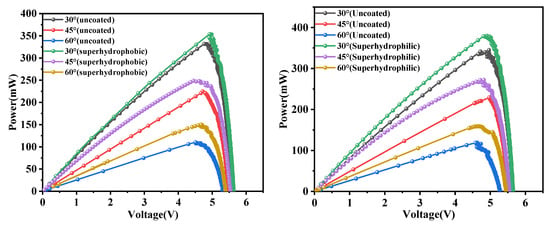
Figure 14.
P–V characteristic curves of PV modules with different surfaces at different tilt angles for wind speed of 1.3 m/s.
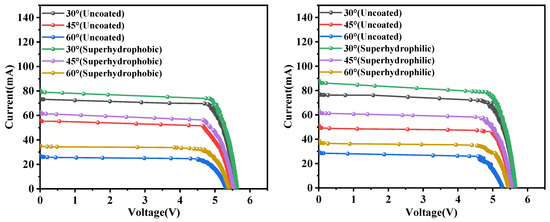
Figure 15.
I–V characteristic curves of PV modules with different surfaces at different tilt angles for wind speed of 1.3 m/s.

Table 2.
Performance parameters of each PV module.
The experimental results show that the Pmax, Uoc, and Isc of the superhydrophobic coated PV module B are increased by 36.0%, 0.6%, and 20.3%, respectively, compared to the uncoated PV module A under the same environmental conditions; the Pmax, Uoc, and Isc of the superhydrophilic coated component D were also higher than those of the uncoated component C. The Pmax, Uoc, and Isc were increased by 33.6%, 3.2%, and 60.4%, respectively. This shows that both coatings are effective in improving the output characteristics of PV modules. Further analysis reveals that the shading effect caused by dust deposition mainly affects the Isc and Pmax of the PV module, while the effect on its Uoc is relatively small. The results are consistent with the results of the literature [39,40], which indicate that the enhancement of the output characteristics of PV modules by superhydrophilic and superhydrophobic coatings mainly stems from the self-cleaning property of their surfaces, which improves the power generation efficiency by reducing shading without altering the electrical characteristics of the PV module inside
4. Conclusions
This study systematically evaluates the dust deposition mitigation performance of superhydrophobic and superhydrophilic coatings on PV modules under varying wind speeds (1.3–5.2 m/s) and tilt angles (30–60°). Through controlled experiments, we characterize the relationship between coating properties, dust accumulation behavior, and PV output power degradation. The key findings are as follows:
- (1)
- Dust deposition density exhibits a consistent inverse relationship with the tilt angle across all surface types, decreasing by approximately 29%~50% as inclination increases from 30° to 60°. While surface coatings significantly alter absolute deposition rates, with superhydrophobic surfaces achieving 88.7% mitigation efficiency versus 46.2% for superhydrophilic variants at 60°, they preserve the fundamental angular dependence trend. This suggests that gravitational settling dominates particle removal dynamics, with coatings modulating adhesion forces at the surface interface.
- (2)
- The dust deposition density of PV modules on different surfaces shows a trend of increasing and then decreasing with the increase in wind speed. The dust deposition mitigation efficiency of PV modules with superhydrophilic coating shows a trend of increasing and then decreasing with the increase in wind speed, and it reaches a maximum of 34% when the inclination angle is 30° and the wind speed is 3.9 m/s. The dust deposition mitigation efficiency of PV modules with superhydrophobic coating increases with the increase in wind speed, and it reaches a maximum of 30.1% when the inclination angle is 30° and the wind speed is 5.2 m/s.
- (3)
- The superhydrophobic coating has a significant advantage in dust deposition mitigation under a high inclination angle and high wind speed, compared with the superhydrophilic coating, which has a smaller advantage in dust deposition mitigation under a small inclination angle and low wind speed. At an inlet wind speed of 5.2 m/s and an inclination angle of 60°, the dust deposition mitigation efficiency of the superhydrophobic coating can reach 88.7%, while the dust deposition mitigation performance of the superhydrophilic coating is 46.2%, which is only 1/2 that of the superhydrophobic coating.
The experimental results demonstrate that superhydrophobic coatings provide a superior dust mitigation performance across a broad range of environmental conditions, particularly excelling under high wind speeds (>3.9 m/s) and steep inclination angles (>45°), where they achieve an 80%–90% deposition reduction. The robust performance of superhydrophobic coatings under high wind speeds (>3.9 m/s) and steep inclination angles (>45°) makes them particularly suitable for PV applications in dust-prone high-latitude and arid regions. However, while excelling in dust mitigation, these harsh environments present additional challenges that require comprehensive evaluation—notably the abrasive effects of wind-borne particulates on coating durability, which demands a focused study on wear resistance. To fully assess real-world applicability, future research must extend beyond the current anhydrous condition focus to systematically investigate precipitation intensity effects, while also incorporating other critical environmental factors including dew formation cycles, temperature fluctuations, and wind-driven debris impact through numerical simulations and extended field testing. Such multifactorial analysis will enable the development of environmentally optimized coatings that maintain their performance across diverse climatic conditions while balancing longevity and cost-effectiveness for practical PV implementation.
Author Contributions
Conceptualization, H.T., C.Z. and H.L.; methodology, H.T.; software, H.T.; validation, H.T., C.Z. and H.L.; formal analysis, H.T. and C.Z.; investigation, H.T., H.L., Y.L., C.X. and J.C.; resources, H.T.; data curation, C.Z. and Y.C.; writing—original draft preparation, H.T.; writing—review and editing, C.Z.; visualization, C.Z. and H.L.; supervision, C.Z.; project administration, H.T.; funding acquisition, H.L. and C.Z. All authors have read and agreed to the published version of the manuscript.
Funding
This research was funded by the National Natural Science Foundation of China (No. 52266017) and the Tianshan Talent Training Program of Xinjiang—Science and Technology Innovation Team (2023TSYCTD0009).
Institutional Review Board Statement
Not applicable.
Informed Consent Statement
Not applicable.
Data Availability Statement
No new data were created or analyzed in this study. Data sharing is not applicable.
Conflicts of Interest
The authors declare no conflicts of interest.
References
- Qiu, T.; Wang, L.; Lu, Y.; Zhang, M.; Qin, W.; Wang, S.; Wang, L. Potential assessment of photovoltaic power generation in China. Renew. Sustain. Energy Rev. 2022, 154, 111900. [Google Scholar] [CrossRef]
- Cho, J.; Park, S.M.; Park, A.R.; Lee, O.C.; Nam, G.; Ra, I.-H. Application of photovoltaic systems for agriculture: A study on the relationship between power generation and farming for the improvement of photovoltaic applications in agriculture. Energies 2020, 13, 4815. [Google Scholar] [CrossRef]
- Tian, L.; Huang, Y.; Liu, S.; Sun, S.; Deng, J.; Zhao, H. Application of photovoltaic power generation in rail transit power supply system under the background of energy low carbon transformation. Alex. Eng. J. 2021, 60, 5167–5174. [Google Scholar] [CrossRef]
- Xu, M.; Xie, P.; Xie, B.C. Study of China’s optimal solar photovoltaic power development path to 2050. Resour. Policy 2020, 65, 101541. [Google Scholar] [CrossRef]
- He, B.; Lu, H.; Zheng, C.; Wang, Y. Characteristics and cleaning methods of dust deposition on solar photovoltaic modules—A review. Energy 2023, 263, 126083. [Google Scholar] [CrossRef]
- Said, S.A.M.; Hassan, G.; Walwil, H.M.; Al-Aqeeli, N. The effect of environmental factors and dust deposition on photovoltaic modules and dust-deposition mitigation strategies. Renew. Sustain. Energy Rev. 2018, 82, 743–760. [Google Scholar] [CrossRef]
- Zaghba, L.; Benbitour, M.K.; Fezzani, A.; Mekhilef, S.; Borni, A. Investigating the theoretical and experimental effects of sand dust and sandstorms on photovoltaic power plants in arid environments. Energy Sustain. Dev. 2024, 81, 101507. [Google Scholar] [CrossRef]
- Khodakaram-Tafti, A.; Yaghoubi, M. Experimental study on the effect of dust deposition on photovoltaic performance at various tilts in semi-arid environment. Sustain. Energy Technol. Assess. 2020, 42, 100822. [Google Scholar] [CrossRef]
- Sadat, S.A.; Faraji, J.; Nazififard, M.; Ketabi, A. The experimental analysis of dust deposition effect on solar photovoltaic panels in Iran’s desert environment. Sustain. Energy Technol. Assess. 2021, 47, 101542. [Google Scholar]
- Gholami, A.; Ameri, M.; Zandi, M.; Ghoachani, R.G.; Eslami, S.; Pierfederici, S. Photovoltaic potential assessment and dust impacts on photovoltaic systems in Iran. IEEE J. Photovolt. 2020, 10, 824–837. [Google Scholar] [CrossRef]
- Xu, L.; Li, S.; Jiang, J.; Liu, T.; Wu, H.; Wang, J.; Li, X. The influence of dust deposition on the temperature of soiling photovoltaic glass under lighting and windy conditions. Sol. Energy 2020, 199, 491–496. [Google Scholar] [CrossRef]
- Xie, J.; Zhao, B.; Zhang, H.; Fu, Z.; Yang, T.; Li, R. Experimental study on the effect of dust particle deposition on photovoltaic performance of urban buildings. Renew. Energy 2023, 219, 119424. [Google Scholar] [CrossRef]
- Sharma, S.; Malik, P.; Sinha, S. The impact of soiling on temperature and sustainable solar PV power generation: A detailed analysis. Renew. Energy 2024, 237, 121864. [Google Scholar] [CrossRef]
- Kumar, A.; Nayak, D.; Nandi, B.K.; Saxena, V.K.; Thangavel, R. Visible light active and self-cleaning SiO2/N-TiO2 heterostructure surface with high transmittance for solar module glass cover: Experimental and DFT insights. J. Environ. Chem. Eng. 2023, 11, 111117. [Google Scholar] [CrossRef]
- Radonjić, I.; Pavlović, T.; Mirjanić, D.; Pantić, L. Investigation of fly ash soiling effects on solar modules performances. Sol. Energy 2021, 220, 144–151. [Google Scholar] [CrossRef]
- Liu, L.; Qian, H.; Sun, E.; Li, B.; Zhang, Z.; Miao, B.; Li, Z. Power reduction mechanism of dust-deposited photovoltaic modules: An experimental study. J. Clean. Prod. 2022, 378, 134518. [Google Scholar] [CrossRef]
- Zheng, C.; Lu, H.; Zhao, W.; Tuo, H.; Xu, C.; Wang, H. Study of ash deposition characteristics of photovoltaic arrays taking into account the effect of photovoltaic module spacing and its effect on output characteristics: Indoor experiment. Energy 2024, 310, 133138. [Google Scholar] [CrossRef]
- Rao, A.; Pillai, R.; Mani, M.; Ramamurthy, P. Influence of dust deposition on photovoltaic panel performance. Energy Procedia 2014, 54, 690–700. [Google Scholar] [CrossRef]
- Alnasser, T.M.A.; Mahdy, A.M.J.; Abass, K.I.; Chaichan, M.T.; Kazem, H.A. Impact of dust ingredient on photovoltaic performance: An experimental study. Sol. Energy 2020, 195, 651–659. [Google Scholar] [CrossRef]
- Zitouni, H.; Azouzoute, A.; Hajjaj, C.; El Ydrissi, M.; Regragui, M.; Polo, J.; Oufadel, A.; Bouaichi, A.; Ghennioui, A. Experimental investigation and modeling of photovoltaic soiling loss as a function of environmental variables: A case study of semi-arid climate. Sol. Energy Mater. Sol. Cells 2021, 221, 110874. [Google Scholar] [CrossRef]
- Liu, Y.; Li, H.; Li, L.; Yin, X.; Su, Z.; Tang, L.; Zhou, S.; Yang, H.; Tian, Z. Research on the electrostatic dust elimination method for solar panels. CSEE J. Power Energy Syst. 2024, 1–11. [Google Scholar]
- Zhao, B.; Yang, J.; Cao, S.; Lv, C.; Fan, S.; Sun, T.; Chen, N. Design of a vacuum-type PV module cleaning robot based on an auxiliary mobile frame. Sol. Energy 2024, 275, 112634. [Google Scholar] [CrossRef]
- Navaei, I.; Rajabi Zargarabadi, M.; Rashidi, S. The effects of water spray characteristics on the performance of a photovoltaic panel. J. Therm. Anal. Calorim. 2024, 1–15. [Google Scholar] [CrossRef]
- Attia, O.H.; Adam, N.M.; As’arry, A.; Md Rezali, K.A. Removal of dust from the solar panel surface using mechanical vibrator. In Journal of Physics: Conference Series; IOP Publishing: Bristol, UK, 2019; Volume 1262, p. 012021. [Google Scholar]
- Zheng, C.; Lu, H.; Zhao, W. Research of dust removal performance and power output characteristics on photovoltaic panels by longitudinal high-speed airflow. Energy 2024, 304, 132202. [Google Scholar] [CrossRef]
- Quan, Z.; Lu, H.; Zhao, W.; Zheng, C.; Zhu, Z.; Qin, J.; Yue, M. A review of dust deposition mechanism and self-cleaning methods for solar photovoltaic modules. Coatings 2022, 13, 49. [Google Scholar] [CrossRef]
- Lu, H.; He, B.; Zhao, W. Experimental study on the super-hydrophobic coating performance for solar photovoltaic modules at different wind directions. Sol. Energy 2023, 249, 725–733. [Google Scholar] [CrossRef]
- Wu, Y.; Du, J.; Liu, G.; Ma, D.; Jia, F.; Klemeš, J.J.; Wang, J. A review of self-cleaning technology to reduce dust and ice deposition in photovoltaic power generation using superhydrophobic coating. Renew. Energy 2022, 185, 1034–1061. [Google Scholar] [CrossRef]
- Zhao, W.; Lv, Y.; Dong, Z.; Zhao, F.; Lv, F.; Yan, W. Effect of self-cleaning superhydrophobic coating on dust deposition and performance of PV modules. Renew. Energy 2024, 227, 120576. [Google Scholar] [CrossRef]
- Piliougine, M.; Canete, C.; Moreno, R.; Carretero, J.; Hirose, J.; Ogawa, S.; Sidrach-De-Cardona, M. Comparative analysis of energy produced by photovoltaic modules with anti-soiling coated surface in arid climates. Appl. Energy 2013, 112, 626–634. [Google Scholar] [CrossRef]
- Zhao, W.; Lu, H. Self-cleaning performance of super-hydrophilic coatings for dust deposition reduction on solar photovoltaic cells. Coatings 2021, 11, 1059. [Google Scholar] [CrossRef]
- Ahmed, A.; Elsakka, M.; Elhenawy, Y.; Amer, A.; Mansi, A.; Bassyouni, M.; Gadalla, M.; Refaat, A. Experimental investigation of a nano coating efficiency for dust mitigation on photovoltaic panels in harsh climatic conditions. Sci. Rep. 2024, 14, 23013. [Google Scholar] [CrossRef] [PubMed]
- Chundi, N.; Ramasamy, E.; Koppoju, S.; Mallick, S.; Kottantharayil, A.; Sakthivel, S. Quantum-sized TiO2 particles as highly stable super-hydrophilic and self-cleaning antisoiling coating for photovoltaic application. Sol. Energy 2023, 258, 194–202. [Google Scholar] [CrossRef]
- Todor-Boer, O.; Petrovai, I.; Tarcan, R.; David, L.; Astilean, S.; Botiz, I. Control of microstructure in polymer: Fullerene active films by convective self-assembly. Thin Solid Film. 2020, 697, 137780. [Google Scholar] [CrossRef]
- Oke, J.A.; Jen, T.C. Atomic layer deposition and other thin film deposition techniques: From principles to film properties. J. Mater. Res. Technol. 2022, 21, 2481–2514. [Google Scholar] [CrossRef]
- Kwok, D.Y.; Neumann, A.W. Contact angle measurement and contact angle interpretation. Adv. Colloid Interface Sci. 1999, 81, 167–249. [Google Scholar] [CrossRef]
- Niu, H.; Luo, S.; Yao, X.; Li, T.; Ai, M.; Zhou, R.; Wang, H.; Wan, L.; Du, Y.; Hu, L.; et al. A review of transparent superhydrophobic materials and their research in the field of photovoltaic dust removal. Mater. Sci. Semicond. Process. 2023, 166, 107741. [Google Scholar] [CrossRef]
- Aljdaeh, E.; Kamwa, I.; Hammad, W.; Abuashour, M.I.; Sweidan, T.; Khalid, H.M.; Muyeen, S.M. Performance enhancement of self-cleaning hydrophobic nanocoated photovoltaic panels in a dusty environment. Energies 2021, 14, 6800. [Google Scholar] [CrossRef]
- Son, J.; Kundu, S.; Verma, L.K.; Sakhuja, M.; Danner, A.J.; Bhatia, C.S.; Yang, H. A practical superhydrophilic self cleaning and antireflective surface for outdoor photovoltaic applications. Sol. Energy Mater. Sol. Cells 2012, 98, 46–51. [Google Scholar] [CrossRef]
- Wang, P.; Xie, J.; Ni, L.; Wan, L.; Ou, K.; Zheng, L.; Sun, K. Reducing the effect of dust deposition on the generating efficiency of solar PV modules by super-hydrophobic films. Sol. Energy 2018, 169, 277–283. [Google Scholar] [CrossRef]
Disclaimer/Publisher’s Note: The statements, opinions and data contained in all publications are solely those of the individual author(s) and contributor(s) and not of MDPI and/or the editor(s). MDPI and/or the editor(s) disclaim responsibility for any injury to people or property resulting from any ideas, methods, instructions or products referred to in the content. |
© 2025 by the authors. Licensee MDPI, Basel, Switzerland. This article is an open access article distributed under the terms and conditions of the Creative Commons Attribution (CC BY) license (https://creativecommons.org/licenses/by/4.0/).